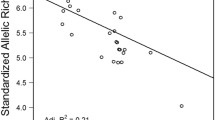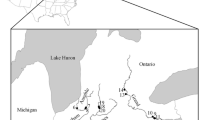Abstract
Understanding dispersal routes of invasive species is essential to their control. Tilapiine fish species are archetypal invaders of freshwater habitats. They were first reported from Australia in the 1970s and have spread rapidly. Incursion into Australia’s largest inland catchment, the Murray Darling Basin, may threaten its largely endemic freshwater fauna. Direct (spatial and temporal distribution) and indirect (genetic data from eight microsatellite loci and mitochondrial DNA sequence) information was used to subjectively construct invasion scenarios. Specifically, we tested the expectation that tilapias have been translocated between freshwater catchments presumably as a consequence of their popularity as bait for angling, display in aquariums and for the table. Five cross-catchment translocation events were inferred involving dispersal across distances up to 300 km. Translocation was not rampant, however, as genetic distinctiveness among catchments was observed. Tilapia in eastern Australia had genetic affinities to Oreochromis spirulus, O. hornourum urolepis and O. aureus, beyond their expected affinity to O. mossambicus. Some individuals had admixed genomes suggesting on-going hybridisation between lineages. Other individuals had zero nuclear genetic diversity at eight microsatellite loci demonstrating the tolerance to severe inbreeding. There was evidence of temporal instability in the composition of populations; for example, in an artificial dam in the south (Tingalpa Weir) one genetic lineage appeared to have replaced another over a period of approximately 20 years. Authorities have clear rationale to more strictly enforce regulations that prohibit possession of this species (dead or alive), and a window of opportunity for effective action given that translocation, while occurring, is currently not rife.



Similar content being viewed by others
References
Abdelkrim J, Pascal M, Samadi S (2007) Establishing causes of eradication failure based on genetics: case study of ship rat eradication in Ste. Anne archipelago. Conserv Biol 21:719–730
Baker CS (2008) A truer measure of the market: the molecular ecology of fisheries and wildlife trade. Mol Ecol 17:3985–3998
Darling JA, Mahon AR (2011) From molecules to management: adopting DNA-based methods for monitoring biological invasions in aquatic environments. Environ Res 111:978–988
Doupe RG, Burrows DW (2008) Thirty years later, should we be more concerned for the ongoing invasion of Mozambique tilapia in Australia? Pac Conserv Biol 14:235–238
Earl DA, vonHoldt BM (2012) STRUCTURE HARVESTER: a website and program for visualizing STRUCTURE output and implementing the Evanno method. Conserv Genet Resour 4:359–361
Estoup A, Largiader CR, Perrot E et al. (1996) Rapid one-tube DNA extraction for reliable PCR detection of fish polymorphic markers and transgenes. Mol Mar Biol Biotechnol 5:295–298
Estoup A, Guillemaud T (2010) Reconstructing routes of invasion using genetic data: why, how and so what? Mol Ecol 19:4113–4130
Evanno G, Regnaut S, Goudet J (2005) Detecting the number of clusters of individuals using the software STRUCTURE: a simulation study. Mol Ecol 14:2611–2620
Falush D, Stephens M, Pritchard JK (2003) Inference of population structure using multilocus genotype data: linked loci and correlated allele frequencies. Genetics 164:1567–1587
Felsenstein J (1985) Confidence limits on phylogenies: an approach using the bootstrap. Evolution 39:783–791
Firmat C, Alibert P, Losseau M et al (2013) Successive invasion-mediated interspecific hybridizations and population structure in the endangered cichlid Oreochromis mossambicus. PLoS One 8:e63880
Gozlan RE, Britton JR, Cowx I et al (2010) Current knowledge on non-native freshwater fish introductions. J Fish Biol 76:751–786
Hedrick PW (1987) Gametic disequilibrium measures: proceed with caution. Genetics 117:331–341
Hohenlohe PA, Bassham S, Etter PD et al (2010) Population genomics of parallel adaptation in three spine stickleback using sequenced RAD tags. PLoS Genet 6:e1000862
Hutchison M, Sarac Z, Norris A (2011) Mozambique tilapia: the potential for Mozambique tilapia Oreochromis mossambicus to invade the Murray-Darling Basin and the likely impacts: a review of existing information. Murray-Darling Basin Authority, Commonwealth of Australia, publication number 153/11
Jakobsson M, Rosenberg NA (2007) CLUMPP: a cluster matching and permutation program for dealing with label switching and multimodality in analysis of population structure. Bioinformatics 23:1801–1806
Kruck NC, Tibbetts IR, Ward RD et al (2013) Multi-gene barcoding to discriminate sibling species within a morphologically difficult fish genus (Sillago). Fish Res 143:39–46
Lee W, Kocher TD (1996) Microsatellite DNA markers for genetic mapping in Oreochromis niloticus. J Fish Biol 49:169–171
Martin CW, Valentine MM, Valentine JF (2010) Competitive interactions between invasive Nile tilapia and native fish: the potential for altered trophic exchange and modification of food webs. PLoS One 5:e14395
Martinsohn JT, Ogden R (2009) FishPopTrace–Developing SNP-based population genetic assignment methods to investigate illegal fishing. Forensic Sci Int: Genet Suppl Ser 2:294–296
Mather P, Arthington A (1991) An assessment of genetic differentiation among feral Australian Tilapia populations. Aust J Mar Freshw Res 42:721–728
Nagl S, Tichy H, Mayer WE et al (2001) Classification and phylogenetic relationships of African tilapiine fishes inferred from mitochondrial DNA sequences. Mol Phylogenet Evol 20:361–374
Ovenden J, White R (1990) Mitochondrial and allozyme genetics of incipient speciation in a landlocked population of Galaxias truttaceus (Pisces: Galaxiidae). Genetics 124:701–716
Ovenden JR, Lloyd J, Newman SJ et al (2002) Spatial genetic subdivision between northern Australian and Southeast Asian populations of Pristipomoides multidens: a tropical marine reef fish species. Fish Res 59:57–69
Page TJ, Hughes JM (2010) Comparing the performance of multiple mitochondrial genes in the analysis of Australian freshwater fishes. J Fish Biol 77:2093–2122
Peakall R, Smouse PE (2006) GenAlEx 6: genetic analysis in Excel. Population genetic software for teaching and research. Mol Ecol Notes 6:288–295
Posada D, Crandall KA (1998) Modeltest: testing the model of DNA substitution. Bioinformatics 14:817–818
Praebel K, Gjelland KO, Salonen E et al (2013) Invasion genetics of vendace (Coregonus albula (L.)) in the Inari-Pasvik watercourse: revealing the origin and expansion pattern of a rapid colonization event. Ecol Evol 3:1400–1412
Pritchard JK, Stephens M, Donnelly P (2000) Inference of population structure using multilocus genotype data. Genetics 155:945–959
Purcell KM, Ling N, Stockwell CA (2012) Evaluation of the introduction history and genetic diversity of a serially introduced fish population in New Zealand. Biol Invasions 14:2057–2065
Roberts DG, Gray CA, West RJ et al (2011) Temporal stability of a hybrid swarm between the migratory marine and estuarine fishes Acanthopagrus australis and A. butcheri. Mar Ecol Prog Ser 421:199–204
Rosenberg NA (2004) Distruct: a program for the graphical display of population structure. Mol Ecol Notes 4:137–138
Rousset F (2008) Genepop 007: a complete re-implementation of the genepop software for Windows and Linux. Mol Ecol Resour 8:103–106
Russell DJ, Thuesen PA, Thomson FE (2012) A review of the biology, ecology, distribution and control of Mozambique tilapia, Oreochromis mossambicus (Peters 1852) (Pisces: Cichlidae) with particular emphasis on invasive Australian populations. Rev Fish Biol Fish 22:533–554
Staden R, Beal K, Bonfield J (1998) The Staden package. Computer methods in molecular biology. In: Misener S, Krawetz S (eds) Bioinformatics Methods and Protocols. The Humana Press Inc., Totowa, NJ 07512, pp. 115–130
Tamura K, Dudley J, Nei M et al (2007) MEGA4: molecular evolutionary genetics analysis (MEGA) software version 4.0. Mol Biol Evol 10:1596–1599
Thuesen PA, Russell DJ, Thomson FE et al (2011) An evaluation of electrofishing as a control measure for an invasive tilapia (Oreochromis mossambicus) population in northern Australia. Mar Freshw Res 62:110–118
Unmack PJ (2001) Biogeography of Australian freshwater fishes. J Biogeogr 28:1053–1089
Van Oosterhout C, Hutchinson WF, Wills DPM et al (2004) MICROCHECKER: software for identifying and correcting genotyping errors in microsatellite data. Mol Ecol Notes 4:535–538
Yue GH, Orban L (2002) Microsatellites from genes show polymorphism in two related Oreochromis species. Mol Ecol Resour 2:99–100
Acknowledgments
We thank John Russell, Michael Hutchison, Andrew Norris, Danielle Stewart, Zafer Sarac, Jessica Morgan and Carlos Bustamante for assisting with aspects of this study. We are grateful for the support of the Murray-Darling Basin Authority and the Cooperative Research Centre for Invasive Animals. Genotype data is available at http://espace.library.uq.edu.au/view/UQ:325954.
Author information
Authors and Affiliations
Corresponding author
Electronic supplementary material
Below is the link to the electronic supplementary material.
Rights and permissions
About this article
Cite this article
Ovenden, J.R., Macbeth, G.M., Pope, L. et al. Translocation between freshwater catchments has facilitated the spread of tilapia in eastern Australia. Biol Invasions 17, 637–650 (2015). https://doi.org/10.1007/s10530-014-0754-6
Received:
Accepted:
Published:
Issue Date:
DOI: https://doi.org/10.1007/s10530-014-0754-6




